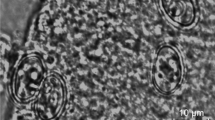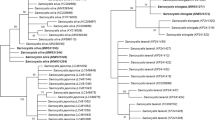Abstract
Epidemiological data and a unique phylogenetic position had suggested that Sarcocystis ovalis in moose and red deer might use a definitive host other than canids, felids, or humans. Corvid birds and rats were therefore evaluated as potential definitive hosts for this species in a small pilot study. Four laboratory rats were each inoculated with 10 or 25 sarcocysts of S. ovalis isolated from moose, but no Sarcocystis oocysts were detected in their intestinal mucosa upon euthanasia 2 to 3 weeks later. At a site where large flocks of corvid birds (hooded crows, ravens and European magpies) fed on remnants of moose carcasses during the hunting period in October, fresh bird droppings were collected on the ground and examined microscopically and by molecular methods. By microscopy, a small number of typical Sarcocystis sporocysts, measuring 12.8 × 8.4 μm, were found in the faecal samples. These sporocysts were identified as belonging to S. ovalis by a polymerase chain reaction assay using specific primer pairs targeting the ssu rRNA gene, followed by sequence analysis. The intestinal contents of a crow and two magpies shot near the dumping site were also examined. Sarcocystis oocysts (16.1 × 12.4 μm) and free sporocysts (12.5 × 7.9 μm) were found in the intestinal mucosa/contents of one magpie (Pica pica). These oocysts/sporocysts were also found to belong to S. ovalis by the same molecular assay. This is the first report of corvid birds acting as definitive hosts for a species of Sarcocystis.


Similar content being viewed by others
References
Černá Z (1984) The role of birds as definitive hosts and intermediate hosts of heteroxenous coccidians. J Protozool 31:579–581
Colwell DD, Mahrt JL (1981) Ultrastructure of the cyst wall and merozoites of Sarcocystis from moose (Alces alces) in Alberta, Canada. Z Parasitenkd 65:317–329
Dahlgren SS, Gjerde B (2007) Genetic characterization of six Sarcocystis species from reindeer (Rangifer tarandus tarandus) in Norway based on the small subunit rRNA gene. Vet Parasitol 146:204–213
Dahlgren SS, Gjerde B (2008) Sarcocystis in moose (Alces alces): molecular identification and phylogeny of six Sarcocystis species in moose, and a morphological description of three new species. Parasitol Res 103:93–110
Dahlgren SS, Gjerde B (2009) Sarcocystis in Norwegian roe deer (Capreolus capreolus): molecular and morphological identification of Sarcocystis oviformis n. sp. and Sarcocystis gracilis and their phylogenetic relationship with other Sarcocystis species. Parasitol Res 104:993–1003
Dahlgren SS, Gjerde B (2010a) Molecular characterization of five Sarcocystis species in red deer (Cervus elaphus), including Sarcocystis hjorti n. sp., reveals that these species are not intermediate host specific. Parasitology 137:815–840
Dahlgren SS, Gjerde B (2010b) The red fox (Vulpes vulpes) and the arctic fox (Vulpes lagopus) are definitive hosts of Sarcocystis alces and Sarcocystis hjorti from moose (Alces alces). Parasitology 137:1547–1557
Dahlgren SS, Gjerde B, Skirnisson K, Gudmundsdottir B (2007) Morphological and molecular identification of three species of Sarcocystis in reindeer (Rangifer tarandus tarandus) in Iceland. Vet Parasitol 149:191–198
Dahlgren SS, Gouveia-Oliveira R, Gjerde B (2008) Phylogenetic relationships between Sarcocystis species from reindeer and other Sarcocystidae deduced from ssu rRNA gene sequences. Vet Parasitol 151:27–35
Doležel D, Koudela B, Jirků M, Hypša V, Oborník M, Votýpka J, Modrý D, Šlapeta JR, Lukes J (1999) Phylogenetic analysis of Sarcocystis spp. of mammals and reptiles supports the coevolution of Sarcocystis spp. with their final hosts. Int J Parasitol 29:795–798
Erber M, Boch J, Barth D (1978) Drei Sarkosporidienarten des Rehwildes. Berl Münch Tierärztl Wsch 91:482–486
Gjerde B (1984a) Sarcocystis infection in wild reindeer (Rangifer tarandus) from Hardangervidda in southern Norway: with a description of the cysts of Sarcocystis hardangeri n. sp. Acta Vet Scand 25:205–212
Gjerde B (1984b) Sarcocystis hardangeri and Sarcocystis rangi n. sp. from the domestic reindeer (Rangifer tarandus) in northern Norway. Acta Vet Scand 25:411–418
Gjerde B (1985a) Ultrastructure of the cysts of Sarcocystis hardangeri from skeletal muscle of reindeer (Rangifer tarandus tarandus). Can J Zool 63:2676–2683
Gjerde B (1985b) Studies on the sarcocyst morphology and life cycle of six species of Sarcocystis from reindeer (Rangifer tarandus tarandus). Thesis, Norwegian School of Veterinary Science, Oslo
Gjerde B (1986) Scanning electron microscopy of the sarcocysts of six species of Sarcocystis from reindeer (Rangifer tarandus tarandus). Acta Pathol Microbiol Immunol Scand B 94:309–317
Grikieniene J, Kutkienė L (1998) New experimental data on the laboratory rat as a definitive host of Sarcocystis rodentifelis. Acta Zool Lituanica Parasitol 8:121–124
Koudela B, Modrý D (2000) Sarcocystis muris possesses both diheteroxenous and dihomoxenous characters of life cycle. J Parasitol 86:877–879
Kutkienė L, Prakas P, Sruoga A, Butkauskas D (2009) Sarcocystis in the birds family Corvidae with description of Sarcocystis cornixi sp. nov. from the hooded crow (Corvus cornix). Parasitol Res 104:329–336
Markus MB, Mundy PJ (1979) Intestinal Sarcocystis infection in vultures and its significance. Parasitology 79:xxxix
Markus MB, Mundy PJ, Daly TJM (1985) Vultures (Gyps spp.) as final hosts of Sarcocystis of impala, Aepyceros melampus. S Afr J Sci 81:43
Mugridge NB, Morrison DA, Johnson AM, Luton K, Dubey JP, Votýpka J, Tenter AM (1999) Phylogenetic relationships of the genus Frenkelia: a review of its history and new knowledge gained from comparison of large subunit ribosomal ribonucleic acid gene sequences. Int J Parasitol 29:957–972
Petersen Æ (1998) Íslenskir fuglar. Vaka-Helgafell, Reykjavik
Røskaft E (1992) Kråkefugler. In: Hogstad O (ed) Norges dyr. Fuglene 4. Cappelen, Oslo, pp 132–161
Šlapeta JR, Modrý D, Votýpka J, Jirků M, Koudela B, Lukeš J (2001) Multiple origin of the dihomoxenous life cycle in sarcosporidia. Int J Parasitol 31:413–417
Votýpka J, Hypsa V, Jirku M, Flegr J, Vávra J, Lukes J (1998) Molecular phylogenetic relatedness of Frenkelia spp. (Protozoa, Apicomplexa) to Sarcocystis falcatula Stiles 1893: is the genus Sarcocystis paraphyletic? J Eukaryot Microbiol 45:137–141
Acknowledgements
The authors would like to thank the company Løvenskiold Skog for allowing us to collect muscle samples from moose and faecal samples from corvid birds, and to examine three corvid birds that had been legally hunted at their property. We would also like to thank the staff at the Animal Facility of the Norwegian Institute of Public Health for assistance with the experiment on rats.
Author information
Authors and Affiliations
Corresponding author
Rights and permissions
About this article
Cite this article
Gjerde, B., Dahlgren, S.S. Corvid birds (Corvidae) act as definitive hosts for Sarcocystis ovalis in moose (Alces alces). Parasitol Res 107, 1445–1453 (2010). https://doi.org/10.1007/s00436-010-2017-5
Received:
Accepted:
Published:
Issue Date:
DOI: https://doi.org/10.1007/s00436-010-2017-5




